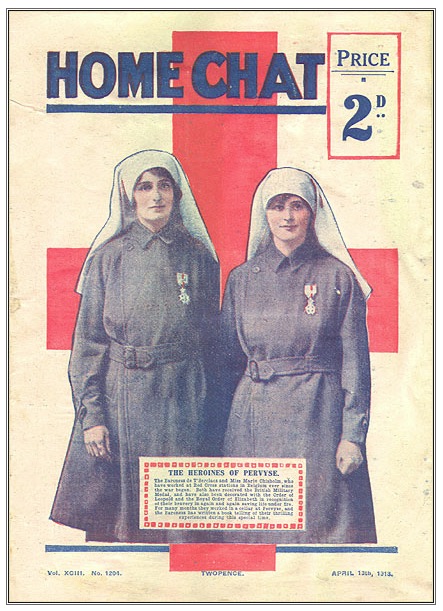
Mairi Chisholm was born in Nairn, Scotland in 1896. When she was a teenager she watched her older brother Uailean racing around the track on his motorbike and longed to do the same. Her mum said proper young ladies did not ride around wildly and get covered in motor oil. Her dad said nothing, but the next day a Douglas motorbike was delivered to the house.

Mairi became an ace driver, and soon she could strip down both bikes and repair them like an expert. By this time her family had moved to Devon, and Mairi went racing around the lanes near her home, much to her mother’s dismay. Another lady motorcyclist named Elsie Knocker was doing the same thing, and soon Mairi and Elsie were best friends competing in motorbike and sidecar trials together.

In 1914, war was declared. Elsie, who was 30 and a nurse, told her friend Mairi there was work to be done. They decided to ride their motorbikes to London and volunteer for the Women’s Emergency Corps. Mairi was only 18, and when she told her parents her plan, her mum was apoplectic! Under no circumstances would she be allowed to do something so unladylike! This time her dad argued back. He thought it was very admirable that Mairi wanted to do her bit for the war effort. While they were arguing, Mairi snuck up to her room and packed a bag. She was off!
Mairi and Elsie became dispatch riders, delivering messages and important documents around London for the British army. Mairi was fearless, zigzagging at high speed through the busy London traffic. When Dr Hector Munro spotted her doing hairpin turns he knew she would be perfect for his Flying Ambulance Corps. He invited her to go to Belgium where she would ride into battle zones and rescue wounded soldiers. She accepted immediately!

Elsie joined too, and her nursing training was a great asset. Mairi and Elsie rode motorbikes with a sidecar, and later a makeshift ambulance (above). They had to sleep in their clothes and work through the night, venturing into no man’s land to rescue downed pilots and wounded men. Often they would carry the men on their backs to the ambulance, and then it was a long drive to the field hospital. Because of the distance, many of the soldiers would die on the journey to hospital, so Mairi and Elsie decided they would have to treat them much more quickly.

They set up a British First Aid Post in a cellar house only 100 yards from the trenches on the Western Front. Sandbags piled around the house protected it from bombing raids, and they wore tall boots to get through the mud and helmets to protect themselves from shrapnel and bullets. For three and a half years, Mairi and Elsie worked to save thousands of lives in this little village called Pervyse in Belgium. When there was a lull in the fighting they would travel back to London to raise funds for their work.

They nursed the wounded men in very difficult conditions with limited space and not much in the way of medicines. Three cats and a fox terrier called Shot kept the rats and mice at bay, and were good company too, boosting morale. In 1918 there was a heavy bombing raid on the village and soon after, a gas attack. The little dog Shot smelled the gas and raised the alarm, so Mairi and Elsie had time to get their gas masks on. Sadly, all four pets were killed by the gas. Mairi and Elsie had to return to London for treatment, and in a few more months the war had ended.
Because of their amazing courage and dedication, Mairi and Elsie were awarded several medals during the war, and they became known as the Madonnas of Pervyse. Their heroism was celebrated and they were photographed and visited by dignitaries more often than any other women during World War I.

After the war, Mairi took up car racing for a while, but her health had suffered and eventually she retired back to the north of Scotland where she lived quietly and raised chickens.

In November 2014, a bronze statue by Belgian sculptress Josiane Vanhoutte was unveiled in a ceremony marking 100 years since Mairi and Elsie set up their first aid station in the cellar house at Pervyse. It stands in a garden in the town of Ypres where numerous war memorials commemorate extraordinary courage and dedication. This statue would not exist without the fundraising efforts of Dr Diane Atkinson, who published a book about the two women, Elsie & Mairi Go to War, in 2009. If you want to know more about the amazing Mairi and Elsie, it’s a good place to start.
In September 2021, Collins Big Cat (a guided reading series for schools) will publish Mairi’s Motorbike, my own telling of Mairi’s amazing story.

